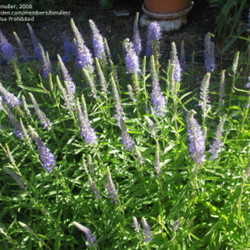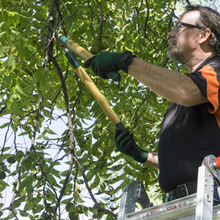(Editor's Note: This article was originally published on March 6, 2009. Your comments are welcome, but please be aware that authors of previously published articles may not be able to respond to your questions.)
With a winter as long as it is in the Rocky Mountains, any persisting signs of green are a welcome sight. Maybe you could find a new evergreen perennial to add to your garden this year.
All of the 'green in winter' pictures in this article were taken in my gardens on February 17; proof that in the dead of winter, there is a light at the end of the tunnel. You might imagine that some natives would be specialized at surviving the winter here in the Rockies, but some other astounding plants are holding their own in my garden this year.

Ice Plant Delosperma nubigenum This low-growing groundcover is extremely cold-hardy, needing no protection or even roots. I received my ice plant as a gift in October with no roots and I just tucked it in next to some plants and it has stayed evergreen and dark pink ever since. Native to South Africa, ice plants are hardy to Zone 4 and come in many different bloom colors. |  |
 | Yellow Storksbill Erodium chrysanthum Yellow storksbill is a completely drought tolerant, hardy perennial native to Greece [1]. Prized equally for its feathery foliage and creamy yellow blooms, the yellow storksbill is related to hardy geraniums. It forms a low spreading mat in even the toughest conditions. In my garden it didn't actually stay green, but growth began to emerge in late January during the most severe part of winter. |  |
Mexican Columbine Aquilegia skinneri 'Tequila Sunrise' Native to many different parts of North America, Europe and Asia, Columbines thrive in cooler weather and are very tough, despite their delicate looking foliage. My ‘Tequila Sunrise' plants stayed green and continued to put out new growth throughout winter. |  |
 | Spike Speedwell Veronica spicata ‘Red Fox' Spike Speedwells make a majestic statement in the garden through the summer and lucky for us, can remain evergreen throughout the winter as well. A native to eastern Canada and northeastern United States, Veronicas are hardy to Zone 3 and are very easy to grow plants [2]. |  |
Blue Fescue Festuca glauca 'Elijah Blue' Blue Fescue is a clump-forming ornamental grass that holds its powder-blue foliage color throughout summer [3]. It is also drought and heat tolerant and remains evergreen through Zone 6. Blue fescue looks good planted alone or en masse and adds an interesting texture to the garden in any season. |  |
 | Colorado Narrowleaf Penstemon Penstemon linarioides var. coloradoensis My Colorado narrowleaf penstemon not only stayed evergreen, but it also never actually stopped growing through the winter. A native to Colorado and surrounding states, this is one tough plant. It puts on delicate, light blue flowers through the summer and can commonly be found wild throughout the western U.S. |
 | Penstemon digitalis 'Husker's Red' One of the most popular penstemons, ‘Husker's Red' has deep green to burgundy evergreen foliage contrasted by white and light pink blooms. It provides interest through the non-blooming season as well as through winter with its dark foliage. ‘Husker's Red' is hardy through Zone 3. |  |
 | Bridge's Penstemon Penstemon bridgesii Bridge's penstemon is a red flowering variety with long, slender leaves. It has remained evergreen in my garden this year and provides additional interest with deep red stems. Bridge's penstemon is a butterfly magnet with its small tubular red flowers and puts on a show almost all summer long. It is native to the western United States. |
Common Sage Salvia officinalis Common sage, also known as kitchen sage, is a small evergreen sub-shrub, with woody stems, grayish leaves, and blue to purplish flowers native to southern Europe and the Mediterranean region [4]. It has stayed green, really a greenish-gray, all winter long here with eastern exposure in my garden. |  |
 | Pincushion Flower Scabiosa columbaria ‘Misty Butterflies' Dwarf Pincushion Flower is native to southern Europe, northeast Africa, & western Asia, where it grows typically in dry chalk grasslands [5]. It stays compact and puts on a colorful show of lavender and pink blooms in early summer and makes an excellent choice for rock gardens. |
Scots Moss Sagina subulata 'Aurea' A bright spot in the garden during the summer, Scots moss is also a source of green through the winter. The foliage seems to deepen in color and is not reliably evergreen. A native to Europe, Scots moss is an excellent ground cover or rock garden specimen. |  |
 | Egyptian Walking Onion Allium x proliferum One of the more interesting evergreens in my garden this year is the Egyptian Walking Onion, which make an interesting addition to any vegetable garden or in an edible border garden. They are hardy to Zone 3 and have stayed green throughout the winter here. Also known as the tree onion, they are thought to be an ancient native to India or Pakistan introduced to Europe by the Romans. You can eat the top bulblets or the basal bulbs for a strong onion flavor which provides a good source of vitamins A and C [6]. |
Iris ‘Amber Ambush' If well mulched and in a protected east or north spot, irises can stay green all winter long. Native North American irises such as I. missouriensis are a good bet for an evergreen specimen. Iris will usually take off comparatively early in the spring to begin new growth and flowering by early summer. |  |
 | Heartleaf Bergenia Bergenia cordifolia Heartleaf bergenia is a very tough plant that is underutilized in the garden. As a native of Siberia, it is well suited for harsh winter climates. A good choice for semi-shady spots, heartleaf bergenia has rubbery textured leaves which stay green and maroon all winter long. |  |
 | Sweet William Dianthus barbatus Native to almost all of North America, sweet Williams are tough and adaptable plants. They are hardy to Zone 3 and have remained evergreen through the winter in my garden. The foliage ranges from bright chartreuse to deep crimson depending on sun exposure. The flowers range in warm shades and put on a great show in early summer [7]. |  |
 | Monkey Grass Liriope spicata A spreading variety known to be invasive in some areas, Liriope spicata is a good edging or groundcover plant that will stay mainly deep green throughout winter if mulched. In colder and drier climates it tends to stay in check and can make an excellent rock garden choice. |
Quite frankly I never imagined that anything could survive our Colorado winters whilst staying green. I have been proven wrong the last couple years and without fail, my perennials all perk back up in the spring. If they can survive here, surely these would be hardy and appreciated plants in your garden.
Photo Credits:
All images are copywrited to the author, except for the following which were uploaded to the PlantFiles by wonderful Dave's members:
| DonnaMack - Husker's Red | JoeGee - Sweet William | hczone6 - Spike Speedwell |
| Gabrielle - Yellow Storksbill | Growin - Ice Plant | TBGDN - Heartleaf Bergenia |
Sources:
[1] http://www.greatplantpicks.org/index.php?page=display&id=2448&searchterm=all
[2] http://plants.usda.gov/java/profile?symbol=VESP80
[3] http://www.paghat.com/bluefescue.html
[4] http://www.nationmaster.com/encyclopedia/Common-sage
[5] http://www.paghat.com/scabiouspinkmist.html
[6] 75 Exciting Vegetables for your Garden, by Jack E. Staub, 2005, page 85.

















